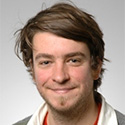 |
April 4, 2013Dr. Mark Lever, Aarhus UniversityEvidence of Microbial Carbon and Sulfur Cycling in Buried Ridge Flank Basalt and General Implications for Life within Earth’s Oceanic Crust |
Abstract
With an area that covers ~60% of the Earth’s surface and an average thickness of ~7 km, sediment-covered flanks of mid-ocean ridges may constitute the largest ecosystem on Earth by volume. Yet, the community composition and metabolic function of organisms inhabiting this vast ecosystem are still largely unknown. We demonstrate the presence of methane- and sulfur-cycling microbes in anoxic, 3.5-million-year-old oceanic crust on the eastern flank of the Juan de Fuca Ridge in the North East Pacific. Depth intervals with functional genes indicative of methane-cycling and sulfate-reducing microorganisms are enriched in solid-phase sulfur and total organic carbon, host δ13C- and δ34S-isotopic values that are evidence of in situ C- and S-cycling, and show clear signs of microbial activity when incubated in the laboratory. Downcore changes in carbon and sulfur cycling reveal an environment in which micro- to macro-scale geochemical and hydrological heterogeneities drive the distribution of microbial activity. Chemoautotrophic δ13C-signatures indicate microbial communities to be largely supported by autochthonous energy from rocks, rather than photosynthesis-derived organic matter. General implications and future directions for the investigation of life in Earth’s potentially largest ecosystem are discussed.
Speaker Biography
Mark Lever is a senior postdoctoral researcher at the Center for Geomicrobiology at Aarhus University, Denmark. His research interests include anaerobic carbon cycling and development of a DNA extraction method separating extracellular and intracellular DNA from subseafloor environments.

